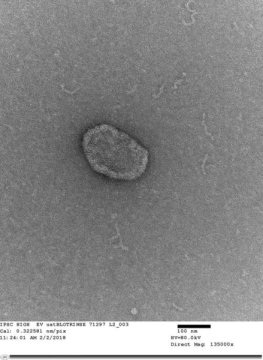[ad_1]
Johns Hopkins scientists report that adult cells reprogrammed to become primitive stem cells, called induced pluripotent stem cells (iPSCs), make tiny “cargo packets” able to deliver potentially restorative or repairing proteins, antibodies or other therapies to aged cells. They say the human iPSCs they studied produced much more of the packets, formally known as extracellular vesicles, than other kinds of adult stem cells commonly used for this purpose in research.
Extracellular vesicles are naturally abundant in many types of cells, which use the cargo-containing spheres to communicate with other cells. They are about one one-hundredth the diameter of a cell and can carry anything from fats and proteins to nucleic acids. When a cell releases an extracellular vesicle, other cells nearby slurp up the tiny packet and its contents, making it an attractive target for packaging treatments for diseased cells that are deteriorating or aging prematurely, researchers say.
To package a potential treatment in an extracellular vesicle, scientists typically use a cell called a mesenchymal stem cell, which is found among fat or bone marrow cells and gives rise to other fat and bone cells. Scientists genetically modify the stem cell to produce vesicles with the treatment-related cellular therapy — usually a protein.
But the Johns Hopkins scientists say that mesenchymal stem cells aren’t the best sources for extracellular vesicles. The cells don’t multiply as often as iPSCs, and more cells are necessary to produce larger quantities of extracellular vesicles needed for therapeutic use. In addition, mesenchymal cells grow best in a liquid called fetal bovine serum, which contains potentially treatment-contaminating extracellular vesicles that are difficult to distinguish and separate from extracellular vesicles derived from mesenchymal cells.
By contrast, the liquid used to store and feed human iPSCs in the laboratory, called Essential 8, is free of extracellular vesicles and animal proteins, and the Johns Hopkins scientists found the cells could produce 16 times more vesicles than mesenchymal stem cells.
“We wanted to show other scientists working on such potential therapies that human iPSCs can efficiently produce highly purified extracellular vesicles that could, one day, be used to treat aging-related diseases,” says Linzhao Cheng, Ph.D., a professor of medicine and oncology at the Johns Hopkins University School of Medicine and a member of the Johns Hopkins Kimmel Cancer Center.
Cheng and his colleague Vasiliki Machairaki, Ph.D., assistant professor of neurology at the Johns Hopkins University School of Medicine, postdoctoral fellow Senquan Liu and other colleagues reported results of their experiments online Feb. 27 in Stem Cells.
The scientists fed extracellular vesicles made from human iPSCs and mesenchymal cells to human cells that had been genetically engineered to model a disease called progeria, which ages cells far more quickly than normal cells. When the scientists broke open the human recipient cells and analyzed their proteins, they found a more than two-fold increase in the amounts of several antioxidant proteins, called peroxiredoxins, inside the cells fed with extracellular vesicles made from iPSCs, which prevented the aging-related damage to cells. Antioxidants help to prevent aging-related damage to cells.
Cheng says that iPSCs may one day be best suited for delivering treatments for cellular aging-related diseases such as progeria and ALS (or Lou Gehrig’s disease), but not other age-related diseases such as cancer because iPSCs are naturally designed for promoting cell growth and regeneration, a process that can fuel cancer.
Machairaki cautioned that a great deal of research is needed before vesicles are deemed effective and safe for human disease therapy. The research team, she says, is currently planning studies in animal models to figure out how to overcome the potential for the immune system to reject extracellular vesicles, for example.
The Johns Hopkins scientists have filed for a patent related to the technology described in this report.
Other scientists who contributed to the research include Hao Bai, Zheng Ding, Jiaxin Li and Kenneth W. Witwer from Johns Hopkins.
The research is funded by the Maryland Stem Cell Research Fund and National Institutes of Health (R56 AG-057430).
[ad_2]















